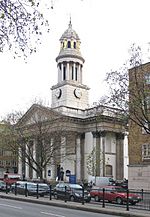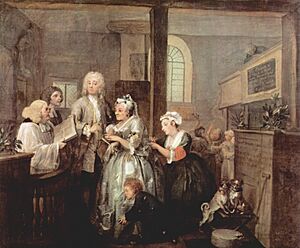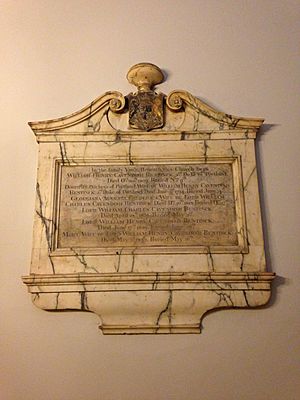St Marylebone Parish Church facts for kids
Quick facts for kids St Marylebone Parish Church |
|
|---|---|
 |
|
| OS grid reference | TQ 28285 82034 |
| Location | 19 Marylebone Road London NW1 5LT |
| Country | England |
| Denomination | Church of England |
| History | |
| Status | Parish church |
| Architecture | |
| Functional status | Active |
| Heritage designation | Grade I listed |
| Architect(s) | Thomas Hardwick |
| Specifications | |
| Number of towers | 1 |
| Administration | |
| Archdeaconry | Charing Cross |
| Diocese | Diocese of London |
St Marylebone Parish Church is an Anglican church located on Marylebone Road in London. It was designed by Thomas Hardwick and built between 1813 and 1817. This church is the third one used by the local community. The area of Marylebone actually gets its name from this church! Right behind the church, you'll find St Marylebone School, which is a Church of England school for girls.
Contents
History of St Marylebone Churches
The First Church Building
The very first church for the Marylebone area was built around the year 1200. It was located near where Marble Arch is today. This church was dedicated to St John the Evangelist.
The Second Church Building

In 1400, the Bishop of London allowed the people to take down the old St John's church. They built a new one in a better spot, closer to the village. This new church was dedicated to the Virgin Mary. It was at the north end of Marylebone High Street.
Many important events happened here. Francis Bacon got married in this church in 1606. The famous artist William Hogarth even showed the inside of this church in his painting series, "A Rake's Progress" (1735). By 1722, the church was so popular that it needed a smaller helper church, called a chapel-of-ease. This second church building was eventually taken down in 1740 because it was falling apart.
The Third Church Building
A new, smaller church was built on the same spot and opened in April 1742. It was a brick building with a small bell tower. Inside, it had balconies on three sides. Some old memorials from the previous church were kept here.
In 1818, this church became a chapel-of-ease when the current, larger parish church was built. It was taken down in 1949. Today, its location at the north end of Marylebone High Street is a public garden.
Many famous people were connected to this third church. Charles Wesley, a leader of the Methodist movement, asked to be buried in its churchyard. His memorial stone is still in the gardens nearby. His son, Samuel, later became the organist at the current church.
Lord Byron was baptized here in 1788. Admiral Horatio Nelson attended services here, and his daughter Horatia was baptized in this church. The diplomat Sir William Hamilton married Emma Hart here. The architect James Gibbs was also buried here in 1751.
The Current Church Building
Planning and Original Design

People first thought about building a new church in 1770. Plans were made by Sir William Chambers. The Dukes of Portland, who owned much of the land, supported the idea. However, the plan was put aside.
Later, in 1810–11, a spot was found for a new chapel. Thomas Hardwick, a student of Chambers, drew up the plans. The first stone was laid on July 5, 1813. As construction neared completion, it was decided that this new building would become the main parish church. So, some changes were made to the design.
Instead of a smaller portico (the entrance with columns), a grander one with eight Corinthian columns was added to the front. This was inspired by the Pantheon in Rome. A tall steeple was also built instead of a dome.
Inside, the church was mostly rectangular. It had two levels of balconies supported by iron columns. The organ was placed above the altar. The church was finished in 1817 and cost about £80,000.
Many well-known people have connections to this church. The writer Charles Dickens lived nearby, and his son was baptized here. This event was even featured in his book Dombey and Son. The poets Robert Browning and Elizabeth Barrett were married in this church in 1846. Their marriage certificate is kept in the church's records.
The composer Sir John Stainer wrote a special musical piece called The Crucifixion for the church's choir. It was first performed there on February 24, 1887. It has been performed every year since, usually on Good Friday.
Changes Over Time
In 1826, some parts of the organ area were changed. The private balconies were replaced with new ones for students from the National School.
In 1882, the church underwent a big renovation led by the rector, Revd. W. Barker. The architect Thomas Harris designed these changes. They removed the back wall and the upper balconies to let in more light. They also created a special area for the choir and a new altar space. New features included a marble floor and a beautiful marble pulpit. These changes were finished in 1885.
After World War II
During the Second World War, a bomb fell near the church. It broke all the windows and damaged the ceiling. The church had to close for repairs until 1949. When it reopened, pieces of the original stained glass were put into the new windows. A special area called the Browning Chapel was created to remember the marriage of Robert and Elizabeth Barrett Browning. This chapel later became a meeting room, and the chapel moved to another part of the church.
Today, the churchyard is a peaceful public garden cared for by the City of Westminster.
Rectors of St Marylebone
The church has a list of its main ministers, called rectors, going back to 1544. In 1821, the role of Rector was fully given back to the clergyman in charge.
- 1821–1825: Luke Heslop
- 1825–1854: John Hume Spry
- 1855–1857: John Pelham
- 1857–1882: Charles Eyre
- 1882–1908: William Barker
- 1908–1942: William Douglas Morrison
- 1942–1954: Hubert Matthews
- 1954–1958: James Harington Evans
- 1958–1978: Frank Coventry
- 1979–1990: Christopher Hamel Cooke
- 1990–1997: John Chater
- 1997–2010: Christopher Gower
- 2010–present: Stephen Evans
Church Organ and Organists
The church has a large organ built by Rieger Orgelbau. It has four keyboards!
Famous Organists
- 1817–1834: Samuel Wesley, son of Charles Wesley
- ????-????: William Hodge, to whom John Stainer dedicated his Crucifixion
- ????-1913: Frederick B. Kiddle, a well-known English pianist and organist
- 1965–1971: Douglas Edward Hopkins
- 1971–1979: Michael Howard
- 1979–1991: Catherine Ennis
- 1991–2001: Peter Barley
- 2001–2014: Steven Grahl
- 2014–present: Gavin Roberts
Notable Burials

Many important people have been buried at St Marylebone Parish Church. Some members of the Bentinck family were buried in the church's crypt (an underground vault). These include:
- William Cavendish-Bentinck, 3rd Duke of Portland (1738–1809), who was a Prime Minister of the United Kingdom.
- Dorothy Cavendish-Bentinck, Duchess of Portland (1750–1794).
- Lieutenant-General Lord William Cavendish-Bentinck (1774–1839), who was the Governor-General of India.
Other notable people buried in the churchyard (which is now a public garden) include:
- Archibald Bower (1686–1766), a Scottish historian.
- Richard Cosway (1742–1821), a portrait painter.
- James Figg (died 1734), a famous boxer.
- John Shore (1751–1834), who was the Governor General of India.
- The Reverend Charles Wesley (1707–1788), known for writing over 6,000 hymns. His wife, Sarah, is also buried there.
- Joseph Woelfl (1773–1812), a composer and pianist.
Art Exhibitions
Since 2013, the church has hosted art exhibitions in its crypt. These shows feature living British painters. The exhibitions are a partnership with a group called Contemporary British Painting. Some of the artists who have shown their work there include Matthew Krishanu, Claudia Böse, Mary Webb, and Susan Gunn.
See also
 In Spanish: Iglesia parroquial de St. Marylebone para niños
In Spanish: Iglesia parroquial de St. Marylebone para niños

